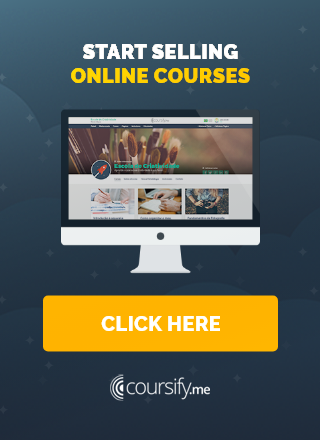Selling online courses: 5 marketing tips for beginners
Selling online courses is a very attractive alternative for different types of professionals.
Even those who do not teach as their main activity see the option of recording educational videos and making them available on virtual platforms as an opportunity for extra income. However, creating a course is one thing, selling it is another.
To help those entering this market, we have put together five marketing tips for beginners that are simple to understand and apply.

5 marketing tips for selling online courses
The potential for gains in scale and the low-cost advertising opportunities go hand in hand in online business. These are advantages that are too good to ignore, that’s the appeal of selling online courses.
However, it is easy to get lost in advertising actions when you are a beginner. Knowing how to persuade consumers requires method and strategy.
With the 5 marketing tips we’ve put together, you can take the first steps towards selling online courses with a pragmatic vision.
1. Offer a free sample
Offering a free sample is a great strategy for those who are just starting out and need to attract an audience and prove authority.
To promote and sell online courses, free samples can be offered in different ways, as we will see below.
Simple samples
The advantage of offering simpler samples is precisely that less work is required to prepare something.
In these cases, it is recommended to use some material you already have, such as a written work or recorded class, and transform this material into smaller content, such as a presentation, short videos, etc.
Write articles, for example, tends to be the least expensive way to offer course previews for free.
Lessons can be structured briefly in text to expound ideas and prove authority.
This type of content can be published on your own blog, on specialized websites, used as a lead magnet and even posted in parts on social media to attract an audience.
Short videos are another alternative, although this option, depending on the expected result, may be a little more expensive.
Depending on your familiarity with technology, there may or may not be a need to hire professionals to edit the content or even a studio and equipment. However, nothing stops you from turning your smartphone towards you and starting filming. We only advise you to invest in a microphone to ensure audio quality.
After all, no matter how simple your promotional content is, for selling online courses people need to hear what you have to say.
– Creating videos: how to get good results while spending little
Complex samples
The most complex and labor-intensive samples to formulate have the advantage of greater depth in the content, which can be useful to attract the most demanding customers.
Writing and making available an eBook on a topic is one of these types of samples. No matter how brief the volume, in this case, the effort will not be just to write it. The layout and visual identity are also essential details for a good result.
Distribution can be facilitated with self-publishing tools such as Amazon and other companies, but it can also be done through your own website or social networks.
Another idea is to format lessons from a course module into an email sequence, which invites you to watch the complete (paid) course at the end.
The effort to create this type of material is greater because, firstly, it requires a lot of organization. E-mails are generally brief, so the content must be offered in small pieces in each message.
The text must be appealing and generate curiosity. The good news is that you can count on artificial intelligence tools for this.
– 8 Best AI Tools for Writing Emails
The advantage of emails is having direct access to the inbox of potential consumers, where attention tends to be greater than in the increasingly impersonal feeds of social networks. Furthermore, the email can integrate other types of content into the message, such as updates about your courses, periodic news, videos, links to a free eBook, etc.
Finally, another idea is to create a free online mini-course. It can be delivered in real time, promoted via live streaming tools, or recorded once and made available on an LMS platform or on your own website.
The important thing is to be thought-provoking and offer a call to action to promote your major course.
– Step by step to create an online mini-course
2. Create shorter “gateway” courses
An interesting alternative to the free sample for promoting and selling online courses could be to provide a shorter version of the course at a lower price.
Many people are after very specific knowledge and skills. Your course may be too comprehensive, long and expensive for this audience.
Breaking it down into smaller parts with objective approaches can yield parallel sales for people with varied interests.
So, consider thinking about how to recontextualize the course you already have recorded or simply shorten it.
Perhaps some modules can be reorganized, divided or re-recorded without much effort to meet more specific demands.
In these shorter courses, you can also advertise the opportunity for further development with your full course, which is your main product.
3. Know your competition
More as a guide for planning marketing actions than as a one-off measure, knowing the competition is a necessity that first-time virtual entrepreneurs cannot ignore.
To get started, you can check what the competition is offering on platforms focused on selling online courses, social media, Google search results, etc.
However, the interesting thing is to go beyond national borders to expand your notions regarding both the creation of the course and the sales and advertising strategies.
Researching what people working in the same area are doing in different countries presents barriers of different natures, but which can be overcome.
Automatic translators and subtitles are increasingly powerful for deciphering content. At the same time, VPN tools are an excellent measure of mask IP and overcome geolocation blocking impositions, both for viewing content and payment conditions.
Structuring and selling online courses has varied nuances that go far beyond the presentation of the content.
This kind of prospecting on platforms in other countries can be especially useful to see more possibilities from an operational and commercial point of view.
– 3 ways to validate your idea before creating online courses
4. Establish partnerships
Getting traction on word-of-mouth advertising starting from scratch is not simple. Therefore, establishing partnerships is an excellent way to build bridges and gain space with new audiences.
Nowadays, podcasts and vodcasts spread quickly. Many fields of activity offer programs for interested listeners and contacting them to participate can generate good opportunities.
To create guest posts on specialized websites it is also a relatively simple type of partnership to achieve.
List publications that interest you and contact them directly, demonstrating what you have to offer.
Finally, personal contact in social circles you frequent (associations, clubs, educational institutions, virtual groups) and attendance at conferences in your sector cannot be ignored as opportunities to create connections and structure joint actions.
– Everything you need to know about Guest Post
5. Create a community
A relevant fact about selling online courses is that the content is not the only criterion for choosing consumers: customer support and indication of who attends the course are also key selling points.
The totality of people interested in either the content, support or interaction forms a community. To create and maintain a community in a decent way, it is essential to have a virtual presence.
This is a work of patience and consistency, and can vary depending on the course and professional.
It is recommended to regularly create content on at least one social network that best serves the course’s theme and audience, and one messaging channel.
Daily posts on social media are useful for attracting the attention of new audiences and generating interaction.
The messaging channel (Telegram, WhatsApp, Discord) is useful for maintaining direct dialogue, preferably daily, with those who already know your proposal and want to delve deeper into it.
Such tools also allow for eventual automated triggering, which helps to maintain the communication in busy times.
Consistent and quality work is essential both to captivate people who are not familiar with your course and those who are already customers and want to get more out of the experience.
In this sense, the expansion of the community may imply the hiring of assistants to maintain the support and interaction efficiency.
Periodic events, such as webinars and live broadcasts on social networks are also useful for new audiences to discover interest in what you have to offer.
However, care must be taken to assess the real demand for these events to adjust the frequency. After all, you don’t want to invest an hour to entertain a rotating audience of half a dozen people every week.
– Facebook groups: advantages for your business
Time to start selling online courses

From a large universe of strategies for selling online courses, these five are the ones that we consider the easiest to start applying to get results. However, they all require effort and planning to make this happen.
Invest the necessary time in each of them, without trying to do everything at the same time. Thus, it will be possible quantify the efficiency of each, learn how to perform them properly and understand what works best for your strategy for selling online courses.
Complete eLearning platform, Coursify.me it’s the ideal solution for anyone who wants to create, sell and promote courses on the internet.
Serving businesses and professionals in more than 60 countries, Coursify.me is a dynamic and customizable Learning Management System (LMS).
– Learning Management System: What is it?
To know more, visit our website, test the platform and understand why we are the best option for your online course.

